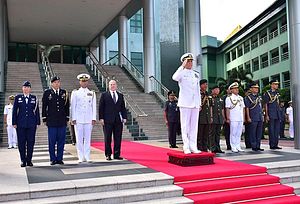Last week, the chief of U.S. forces in the Indo-Pacific paid a trip to Brunei. Though the visit itself was just the latest interaction between the two sides, it nonetheless put the focus on some of the ongoing activity within the broader defense relationship between them.
As I have observed previously in these pages, the United States and Brunei – a small but nonetheless important player in Southeast Asia on a range of regional security issues in the Indo-Pacific region from terrorism to the South China Sea – have an ongoing defense relationship, which includes various bilateral components such as ship visits, staff talks, and exchanges, along with other wider multilateral components as well such as the Southeast Asian state’s involvement in the Cooperation Afloat Readiness and Training (CARAT) exercise and the Southeast Asia Cooperation and Training (SEACAT) drills.
Over the past few years, both sides have continued to develop the U.S.-Brunei defense relationship amid wider domestic and regional developments. As they have done so, we have seen a mix of ongoing developments including Brunei’s participation in the Rim of the Pacific (RIMPAC) exercise and newer manifestations of military ties, be it the holding of the first bilateral army exercise between the two countries under the segment of Pacific Pathways in August 2018.
Last week, the defense aspect of the relationship was in the headlines again with the visit of the Commander of the United States Indo-Pacific Command (INDOPACOM). INDOPACOM chief Philip Davidson was on a trip to Brunei from September 9 to September 10 which constituted his introductory visit to the Southeast Asian state in his current capacity, which he had assumed back in May 2018.
The visit comprised a series of interactions. In terms of meetings, he paid courtesy calls on Brunei’s second minister of defense and the commander of the Royal Brunei Armed Forces (RBAF) and also had an audience with the the head of state Hassanal Bolkiah, also concurrently holds the defense minister portfolio.
Per Brunei’s defense ministry (MINDEF), during the meetings and the visit more generally, both sides affirmed their defense relationship and also discussed specific aspects of ongoing security-related interactions. They also discussed contemporary defense issues and developments of mutual interest, including the recently held US-ASEAN Maritime Exercise that was held in early September.
Unsurprisingly, few additional specifics were publicly provided by either side on their private deliberations, including potential additional collaboration that may be in the works for the rest of 2019 and further out. Nonetheless, the evolution of the U.S.-Brunei defense relationship will continue to be interesting to watch in the years that come amid wider domestic and regional developments and how both sides respond to them.
































